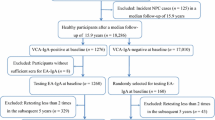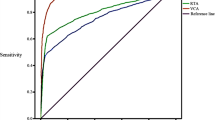Nasopharyngeal carcinoma (NPC) patients have elevated IgG and IgA antibody titers against the Epstein-Barr viral capsid antigen (VCA) and the diffuse component of the early antigen complex (EA-D) at diagnosis. Several studies have implied that the presence of anti-VCA-IgA can be used as a screening marker for early NPC. To evaluate this further, we undertook a serologic case-control study based on four serum banks which together had specimens from over 240,000 persons. Seven cases of undifferentiated or poorly differentiated NPC were diagnosed in the period after serum collection ranging from 26 months to 154 months. Two controls per case matched on serum bank, age, sex, race, and date of serum collection were selected by a predetermined random process. For anti-VCA-IgG, the geometric mean titer for cases (88.3) was significantly higher than that for controls (75.5, P<0.05). The difference was greatest among the Asian patients. No significant differences were found for anti-VCA-IgA, anti-EA-D, and anti-EA-R or anti-EBNA. No time effects were evident when titers were plotted against time of blood collection preceding diagnosis, Our results do not suggest EBV activation in the period preceding NPC diagnosis, not that detectable IgA antibody against VCA is a marker for early disease.
Similar content being viewed by others
References
Schryverde A, Friberg S, Klein G, et al. Epstein-Barr virus-associated antibody patterns in carcinoma of the post-nasal space. Clin Exp Immunol 1969; 5: 443–59.
Schryverde A, Klein G, Henle W, Henle G. EB virusassociated antibodies in Caucasian patients with carcinoma of the nasopharynx and in long term survivors after treatment. Int J Cancer 1974; 13: 319–25.
Henle W, Henle G, Ho HC, et al. Antibodies to Epstein-Barr virus in nasopharyngeal, other head and neck neoplasms, and control groups. JNCI 1970; 44: 225–31.
Henle W, Ho HC, Henle G, Kwan HC. Antibodies to Epstein-Barr virus-related antigens in nasopharyngeal carcinomas: Comparison of active cases and long term survivors. JNCI 1973; 51: 361–9.
Lin TM, Yang CS, Ho SW. Antibodies to herpes type virus in nasopharyngeal carcinoma and control group in Taiwan. In: Recent Advances in Human Tumor Virology and Immunology. Tokyo: University of Tokyo Press, 1971: 309–15.
Henderson BE, Louie E, Bogdanoff E, Henle W, Alena B. Antibodies to herpes group viruses in patients with nasopharyngeal and other head and neck cancers. Cancer Res 1974; 34: 1207–10.
Wara WM, Wara DW, Phillips TL, Ammann AJ. Elevated IgA in carcinoma of the nasopharynx. Cancer 1975; 35: 1313–15.
Henle G, Henle W. Epstein-Barr virus-specific IgA serum antibodies as an outstanding feature of nasopharyngeal carcinoma. Int J Cancer 1976; 17: 1–7.
Cheng YC, Chen JY, Glaser R, Henle W. Frequency and levels of antibodies to Epstein-Barr virus-specific DNase are elevated in patients with nasopharyngeal carcinoma. Proc Natl Acad Sci USA 1980; 77: 6162–5.
Hausenzur H, Schulte-Holthausen H, Klein G, et al. EBV DNA in biopsies of Burkitt's tumors and naplastic carcinomas of the nasopharynx. Nature 1970; 228: 1056–8.
Hausenzur H, Schulte-Holthausen H, Wolf H, Dorries K. Attempts to detect virus-specific DNA in human tumors. II. Nucleic acid hybridizations with complementary RNA of human herpes group viruses. Int J Cancer 1974; 13: 657–64.
Nonoyama M, Huang CH, Pagano JS, Klein G, Singh S. DNA of Epstein-Barr virus detected in tissues of Burkitt's lumphoma and nasopharyngeal carcinoma. Proc Natl Acad Sci USA 1973; 70: 3265–8.
Wolf H, zur Hausen H, Becker H. EB viral genomes in epithelial nasopharyngeal carcinoma cells. Nature New Biology 1973; 244: 245–7.
Wolf H, zur Hausen H, Klein G, Becker V, Henle G, Henle W. Attempts to detect virus-specific DNA sequences in human tumors. III. Epstein-Barr viral DNA in nonlymphoid nasopharyngeal carcinoma cells. Med Microbiol Immunol 1975; 161: 15–21.
Desgranges C, Wolf H, de-The G, et al. Nasopharyngeal carcinoma. X. Presence of Epstein-Barr genomes in separated epithelial cells of tumors in patients from Singapore, Tunisia and Kenya. Int J Cancer 1975; 16: 7–15.
Andersson-Anvret M, Forsby N, Klein G, Henle W. Relationship between the Epstein-Barr virus and undifferentiated nasopharyngeal carcinoma: Correlated nucleic acid hybridization and histopathological examination. Int J Cancer 1977; 20: 486–94.
Huang D, Ho JHC, Henle G, Kwan HC. Demonstration of Epstein-Barr virus-associated nuclear antigen in nasopharyngeal carcinoma cells from fresh biopsies. Int J Cancer 1974; 14: 580–8.
Klein G, Giovanella B, Lindahl T, Fialkow PJ, Singh S, Stehlin J. Direct evidence for the presence of Epstein-Barr virus DNA and nuclear antigen in malignant epithelial cells from patients with anaplastic carcinoma of the nasopharynx. Proc Natl Acad Sci USA 1974; 71: 473–41.
Zeng Y. Sero-epidemiological studies on nasopharyngeal carcinoma in China. Adv Cancer Res 1985: 44: 121–38.
Ho JHC, Kwan HC, Ng MH, de The G. Serum IgA antibodies to EBV capsid antigens preceding symptoms of nasopharyngeal carcinoma. Lancet 1978; i: 436–7.
Lanier AP, Henle W, Bender TR, Henle G, Talbot ML. Epstein-Barr virus-specific antibody titers in seven Alaskan natives before and after diagnosis of nasopharyngeal carcinoma Int J Cancer 1980; 26: 133–7.
Zeng Y, Zhang LG, Wu YC, et al. Prospective studies on nasopharyngeal carcinoma in Epstein-Barr virus IgA/VCA antibody-positive persons in Wuzhou City, China. Int J Cancer 1985; 36: 545–7.
Chen JY, Hwang LY, Beasley RP, Chien CS, Yang CS. Antibody response to Epstein-Barr virus-specific DNase in 13 patients with nasopharyngeal carcinoma in Taiwan: A retropective study. J Med Virol 1985; 16: 99–105.
Mueller N, Evans A, Harris NL, et al. Hodgkin's disease and Epstein-Barr virus: altered antibody pattern before diagnosis. New Engl J Med 1989; 320: 689–95.
Statistics and Epidemiology Research Corporation. EGRET User's Manual. Seattle, Washington: SERC, 1988.
Fahraeus R, Fu HL, Ernberg I, et al. Expression of Epstein-Barr virus-encoded proteins in nasopharyngeal carcinoma. Int J Cancer 1988; 42: 329–38.
Young LS, Dawson CW, Clark D, et al. Epstein-Barr virus gene expression in nasopharyngeal carcinoma. J Gen Virol 1988; 69: 1051–65.
Frech B, Zimber-Strobl U, Suentzenich K-O, et al. Identification of Epstein-Barr virus terminal protein I (TP1) in extracts of four lymphoid ecll lines, expression in insect cells, and detection of antibodies in human sera. J Virol 1990; 64: 2759–67.
Longnecker R, Kieff E. A second Epstein-Barr virus membrane protein (LMP2) is expressed in latent infection and colocalizes with LMP1. J Virol 1990; 64: 2319–26.
Rowe DT, Hall L, Loab I, Laux G. Identification of the Epstein-Barr virus terminal protein gene products in latently infected lymphocytes. J Virol 1990; 64: 2866–75.
Hitt MM, Allday MJ, Hara T, et al. EBV gene expression in an NPC-related tumor. EMBO J 1989; 8: 2639–51.
de The G. Zeng Y, Population screening for EBV markers: Toward improvement of nasopharyngeal carcinoma control. In: Epstein MA, Achong BG, eds. The Epstein-Barr Virus: Recent Advances. London: William Heinemann Medical Books, 1986.
Ringborg U, Henle W, Henle G, Ingimarsson S, Klein G. Epstein-Barr virus specific serodiagnostic tests in cancers of the head and neck. Cancer 1983; 52: 1237–43.
Zeng Y, Zhong JM, Li JY, et al. Follow-up studies on Epstein-Barr virus IgA/VCA antibody-positive persons in Zangwu County, China. Intervirology 1983; 20: 190–4.
Author information
Authors and Affiliations
Additional information
GC, EJ, KM, NO, and JV are members of the EBV-NPC collaboration. BFP was a member of the EBV-NPC collaboration. This study was supported by PHS grants CA31747, CA30433, BRSG RR05446, BRSG RR05443, National Institutes of Health, Department of Health and Human Services and by a staff training fellowship from the Science University of Malaysia to C. K. Chan. The follow-up of the HDFP study population is supported by PHS grant CA34937.
Deceased
Rights and permissions
About this article
Cite this article
Chan, C.K., Mueller, N., Evans, A. et al. Epstein-Barr virus antibody patterns preceding the diagnosis of nasopharyngeal carcinoma. Cancer Causes Control 2, 125–131 (1991). https://doi.org/10.1007/BF00053132
Received:
Accepted:
Issue Date:
DOI: https://doi.org/10.1007/BF00053132




